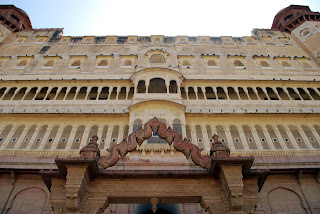Bewitching Bikaner
Reached Bikaner at 4.30 am after a 6 hour bone rattling train ride from Jaisalmer. Needed 2 more hours of sleep in the cosy comfort of a hotel bed to get back my equilibrium. Walked 2 kms from the hotel to Junagarh Fort, making mental notes of sweetmeat shops. There was a huge shop selling just ghee out of large tins.
Normally one associates forts with hills, but Junagarh Fort is a glorious exception; yet it has never been conquered in its history. The Fort throws its doors open to visitors at 10 am. After buying a ticket priced at a measly Rs30, you are asked to wait till a group of ~20 is formed. You are then taken on an hour long free guided tour of the courtyards and palaces within the fort. The guide was good and laced his descriptions with some wry humour on the royal lifestyle. After the guided tour ended, I retraced the path going berserk with my camera. Most surprisingly there is no camera fee. Instead of struggling with words to describe what I saw, let my pictures talk to you. Here is a sample of what you can expect to see in Junagarh Fort.
Normally museums tend to be boring, especially government museums. But Ganga Government museum is altogether different. Named after Maharaj Ganga Singh, who took the help of an Italian scholar to put together the exhibits, for mere Rs5, this small museum allows you to learn some interesting details about sword making and firmans issued by Mughal emperors praising the Rajput kings. Unfortunately photography is forbidden here. Also the section on miniature paintings was closed. When I asked, I got two answers – lack of staff to man the section and that the paintings have been shifted to Jaipur; don’t know what to believe.
Some 11 kms out of the city is located the National Research Centre on Camel. Most contrary to its pedantic name, this is an excellent tourist spot. For Rs20 plus an additional Rs30 for camera, visitors can enjoy watching hundreds of camels jostling with each other for feeding. There is a small museum which explains the differences between the four main Indian camel breeds – Jaisalmeri, Bikaneri, Kachchi and Mewari. There is also a parlour selling camel milk, camel tea and kulfis made out of camel milk. There are also souvenir shops selling products made from camel hair, bones and leather. It is a wonderful tourism initiative by the government and you will come out with a newfound respect and love for this amazing animal
On the way back to the city I stopped at Devi Kund, which houses the cenotaphs (chhatris) of the royal family of Bikaner. There was no other visitor and the caretaker told me that hardly anyone comes here. Such a shame because they are missing out on some good frescoes.
My autorickshaw driver then took me through the narrow lanes of the walled city for the last sight of the day – the beautiful Bhandasar Jain Temple














Comments
Post a Comment